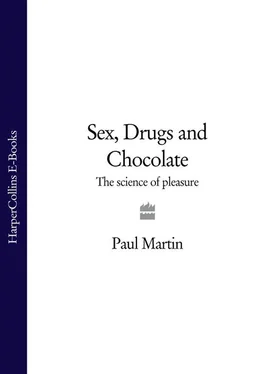The two-way relationship between facial expression and emotion has been substantiated by more systematic experiments. In one study, psychologists got people to hold a pencil between their teeth without it touching their lips. This made them smile, without being consciously aware of doing so. As William James would have predicted, the physical act of smiling lifted their subjective mood, even though the subjects did not know they were smiling. By comparison, sucking a pencil with their lips wrapped around it did nothing to lift their mood. Similar mood-enhancing effects have been produced by giving experimental volunteers detailed instructions to move particular muscles in their face, causing them unwittingly to smile. The effect is strongest when the smile is of the so-called Duchenne variety – the ‘genuine’ type of smile that involves the corners of the eyes as well as the mouth. One day, perhaps, the well-read pleasure-seekers among us will be recognisable from the tell-tale pencil clenched between their teeth.
Deliberately smiling really can lift your mood. Try it for yourself. Use a pencil if you must. So too can holding your head high or whistling a happy tune. In each case, a physical act that would normally reflect an underlying emotional state can also elicit that same emotional state. Of course, people who never stop smiling can irritate those of us in a less ebullient mood, especially if their smile is obviously fake. Some celebrities develop a permanent rictus, which can vary from self-satisfied to borderline psychopathic. Nonetheless, they are on to something. Even a fake smile can make us feel a bit better, because the feedback from the facial muscles tells the brain that something good must be happening. The feel-good factor is reinforced if the smile evokes friendly responses from other people. The idea that emotions reflect some sort of mental map of the body’s internal state is further supported by brain-scanning studies, which show that pleasure and other emotions are accompanied by activity in parts of the brain that are known to be involved in monitoring the body’s internal state. 3
At first sight, then, it might appear as though we have cracked the scientific puzzle of pleasure at an awkwardly early stage in this book. According to the simple theory just outlined, activities that are generally good for us are pleasurable and that is why we keep doing them. Pleasure is the brain’s universal currency, which it uses to compare different behavioural options. We plump for the activity that is likely to produce the most pleasure or the least displeasure, having unconsciously taken account of our current biological needs. If this explanation seems too simple, that is because it is too simple.
A moment’s thought will reveal some obvious gaps in this crude model of pleasure. For a start, we clearly are not just slaves to instant gratification. Much of what we and other animals do is guided by our expectations about future rewards, rather than the immediate consequences of our actions. We frequently choose to do things that are unpleasant or even painful in the short term in order to pursue broader or longer-term goals. Getting out of bed and going to work in the morning is a common example. Giving birth and having cosmetic surgery are others. When everything else is equal, we prefer pleasurable activities over unpleasant ones. In the real world, however, everything else seldom is equal. Our behaviour is shaped by context, expectations and a host of other factors.
Even young children can choose to forgo immediate pleasure in order to obtain a larger reward later. This ability, which is known as delay of gratification, is correlated with happiness and intelligence. One long-term study found that the four-year-old children who performed best in a laboratory test of their ability to delay gratification subsequently developed into more socially competent adolescents who did better at school and coped better with stress. Other apes also have the capacity to delay gratification. Chimpanzees were able to demonstrate it in an experiment in which they were given morsels of chocolate. Twenty chocolates were placed, one by one, in front of the chimpanzee over the course of a few minutes. The animal could eat the accumulated chocolates at any stage, but as soon as it ate any it would receive no more. If, on the other hand, it contained its desire, it was allowed to eat all twenty pieces at the end. Chimpanzees adore chocolate, as any highly intelligent being would. Nonetheless, they proved quite capable of resisting the lure of immediate gratification in order to win a bigger chocolaty reward later.
Much of what we might think of as pleasure is actually the anticipation of pleasure or the desire for something we believe will be pleasurable. Charles Darwin highlighted this distinction in The Expression of the Emotions in Man and Animals , published in 1872. He noted that humans and other animals often express feelings of pleasure in the form of movements and sounds – as, for example, when young children laugh, clap their hands and jump for joy. However, Darwin observed that:
It is chiefly the anticipation of a pleasure, and not its actual enjoyment, which leads to purposeless and extravagant movements of the body, and to the utterance of various sounds. We see this in our children when they expect any great pleasure or treat; and dogs, which have been bounding about at the sight of a plate of food, when they get it do not show their delight by any outward sign, not even by wagging their tails.
Freud also recognised that there is more to human motivation than the simple principle of seeking pleasure and avoiding pain in the here and now. In a later work entitled Beyond the Pleasure Principle , he wrote: ‘The most that can be said is that there exists in the mind a strong tendency towards the pleasure principle, but that that tendency is opposed by certain other forces or circumstances, so that the final outcome cannot always be in harmony with the tendency towards pleasure.’ Recognising the anticipatory nature of human motivation, Freud described it as ‘hedonism of the future’.
Another embarrassing flaw in the simple pleasure principle is that many of us spend surprisingly little of our time doing the things that actually give us the most pleasure. This is why most people feel significantly better if they deliberately make themselves spend more time doing pleasant things. Several psychological studies have demonstrated that instructing people to adopt a conscious strategy of engaging more in pleasant activities really does lift their mood, even if they were not depressed to begin with. ‘Pleasant activities training’, as it is called, is demonstrably more effective at raising mood than physical fitness training or daily sessions of introspection. Now, you might regard the revelation that doing nice things makes people feel better as a statement of the blindingly obvious. What is less obvious, however, is why most of us do not already behave in this way. If our behaviour really were driven by the simple pleasure principle of doing what feels good now, our lives should already be crammed full with pleasurable activities. The fact that this is not generally the case is further proof that the truth is more complex.
The simple pleasure principle is clearly not sufficient to explain the intricate reality of human and animal behaviour. We will see later that much of what we do is driven not by pleasure but by desire. Meanwhile, let us take a closer look at the trio responsible for so much of human pleasure: sex, drugs and chocolate.
Конец ознакомительного фрагмента.
Текст предоставлен ООО «ЛитРес».
Прочитайте эту книгу целиком, купив полную легальную версию на ЛитРес.
Читать дальше












